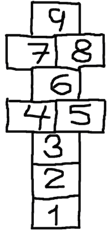| |
EXPLANATION GAMES
|
| |
Loose the duck
Name used in other
European regions:
Name of the person
who explained the game: Ester Rodríguez Esteve, from Riba-roja
d'Ebre (14)
Number of players:
Individually
Ideal place to
do it: River Ebre or Riba-Roja pond.
Material: People
in charge of releasing the ducks go in a canoe.
Explanation:
The organizers release the ducks in the river. Meanwhile, anyone who wants,
can swim in the river to catch a duck. In the old times, people kept the
ducks to fatten them up to eat. Nowadays, they are usually set free on
the river again, this fact has allowed the rebirth of these animals in
the area.
In the last few years
watermelons and melons are thrown into the river.
It's a game traditionally
played in the major fiestas of Flix and Riba-Roja in August.
Explanation of
the same game in other European regions:
Photograph/picture
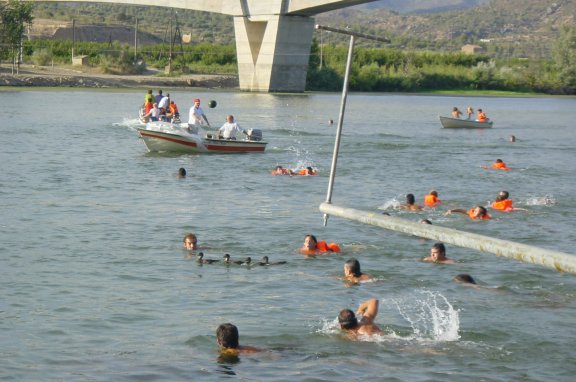
|
| |
Skittles
Name used in other
European regions: Quilles (France)
Name of the person
who explained the game: Mónica Cervelló Arán,
from Riba-roja d'Ebre (13 years old)
Number of players:
You can play individually or compete in pairs.
Ideal place to
play it: A flat piece of ground of a minimum of 12 metres.
Material: You
need 6 wooden skittles.
Explanation:
One game consists of 9 throws per player, divided into 3 throws. In each
throw you can knock down 3 skittles.
Put the skittles in
2 rows of 3 columns, parallel to each other, separated by 7.5 cm I the
low part.
The throwing distance
is 11 metres and a half for men and 9.5 for women.
The main objective
is to knock the skittles down, that is to say, knock down 3 out of 5 skittles.
The throws are scored as follows:
- No skittles down
0 points
- One skittle down
1 point
- Two skittles down
2 points
- Three skittles
down 3 points
- Four skittles down
4 points
- Five skittles down
10 points
- Six skittles down
6 points
- (*)Where we live,
if 6 skittles are knocked down, it is also 0 points.
Explanation of
the same game in other European regions:
Photograph/picture
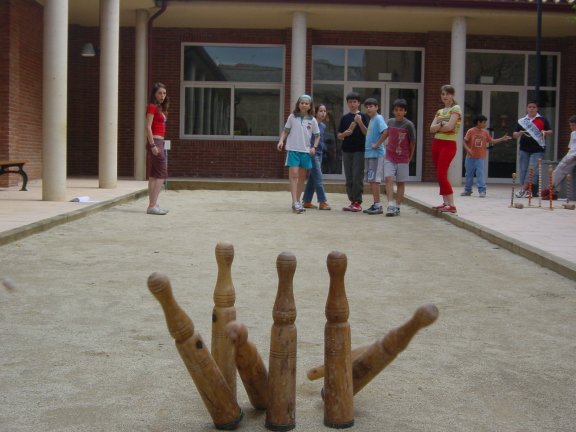
|
| |
The belt
Name used in other
European regions:
Name of the person
who explained the game: Helena Blanc Pérez, Àlex Esplugues
Vidal, Gemma Sonet Guiu, Berta Treig Carranza, from Flix (12) and Soufiane
Boudouf, from Vinebre (12)
Number of players:
12 people minimum
Ideal place to
play it: A level square
Material: A
belt or a scarf
Explanation:
In pairs, one in front of the other, a circle is formed and everybody
looks towards the centre. The person who is behind has to keep his hands
behind his back. The one who is on has a belt and scarf. That person chases
the other one outside the circle and he can hit him with the belt or with
the scarf on his bottom - you run anticlockwise.
The person who is chased, in order to avoid the belt hits, has to be in
front of a couple which forms the circle. In that moment he's not chased
any longer and the one who is outside this couple is the one who has to
run so as not to be caught by the belt.
The one that is on
can give the belt to anyone he wants from outside. That's why they have
their hands behind their backs. If he does so, he has to pretend that
he still has the belt so as to mislead chased person. When this person
goes behind the player who has the belt he will chase now, while the one
that was on will take the place that the other player has left.
It's a traditional and typical game played on St. Miquel Day in the hermitage
in Vinebre. Usually people from 16 to 30 years old play this game.
Explanation of
the same game in other European regions:
Photograph/picture
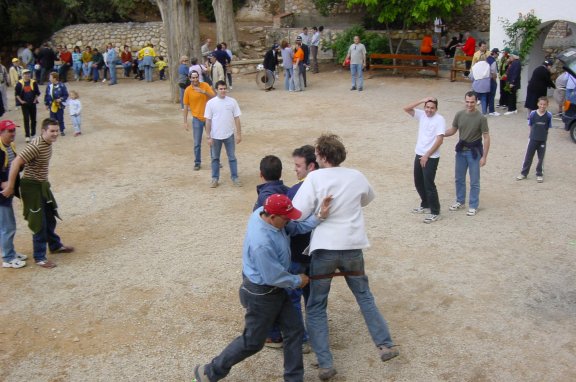
|
| |
Tug of war
Name used in other
European regions:
Name of the person
who explained the game: Carla Fernández Montaña, d'Ascó
(13 ) and Ester Rodríguez Esteve, from Riba-roja d'Ebre (14)
Number of players:
Between 10 and 15 per team
Ideal place to
play it: A flat piece of ground of around 30 metres approximately.
Material: A
thick rope, 20 metres long and a scarf tied to the centre of the rope.
Explanation:
Participants make two teams. Each team is placed on one side of the rope,
which is separated by a scarf tied in the middle of the rope.
Draw a line in the
middle of the playing field. When the game starts the 2 teams begin to
tug the rope. The strongest team has to pull the first member of the other
team across the line.
It's a traditional
game that you can see in Asco on 17th January, for St. Anton, and in Riba-Roja
on Easter Monday. It is usually played by married men against single men
or married women against single women. Sometimes men play against women.
Explanation of
the same game in other European regions:
Photograph/picture
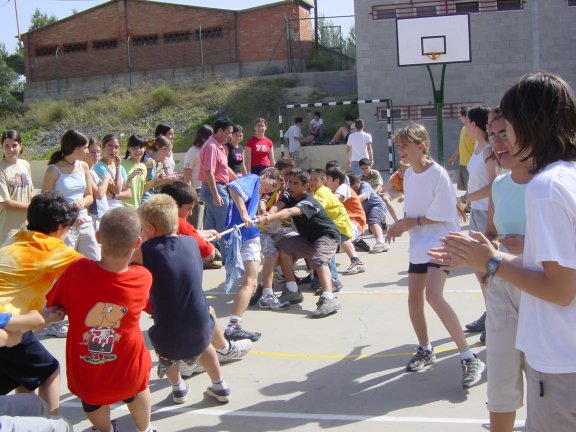
|
| |
The horseshoe
Name used in other
European regions:
Name of the person
who explained the game: Marc Ribes Serra, from Ascó (12 ) and
Zhour Mahjouba, from La Torre de l'Espanyol (12 )
Number of players:
Individual or in pairs
Ideal place to
play it: A square, a playground or a flat area
Material: Three
or more horseshoes and an iron bar about 30 cm long
Explanation:
It's a game we've learnt at the institute. In the olden days, when there
were more horses and mules, people played it more often. Now it is unusual
to see people playing it.
Drive the iron bar
into the ground and draw a 50-60 cm circle around it. Each player has
from 3 to 5 horseshoes. From a distance of 2 m, throw the horseshoes trying
to hook them around the stick, or if not, trying to get inside the circle.
Explanation of the same game in other European regions:
Photograph/picture
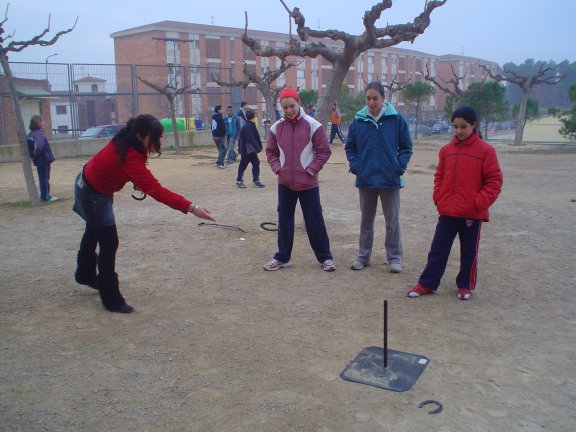
|
| |
Ribbon
race
Name used in other
European regions:
Name of the person
who explained the game: Ester Rodríguez Esteve, from Riba-roja
d'Ebre (14 years old) i Maria Jornet Llop, from Ascó (12 years
old)
Number of players: Individual
Ideal place to
play it: In a street or a square
Material: Every
body needs a bike and a stick which is held in your mouth. The organization
will hold as many ribbons as prizes they want to give. If you play the
game riding a donkey, you need a fork.
Explanation:
The objective is to try to get the maximum number of ribbons hanging on
a rope in the street. The organization hangs a rope from one side to the
other of the street. Ribbons of different colours are hung on the rope
with a ring on the end.
When the game starts,
everybody sets off on a bike with a stick in their mouth to try to catch
the maximum number of ribbons. The one who gets the most is the winner.
This game is played traditionally at the borough fiestas of St. Domingo
in Riba-Roja.
In Ascó, it
is played on 17th January , on a donkey. The player has to get the ribbon
with a pitchfork.
Explanation of
the same game in other European regions:
Photograph/picture
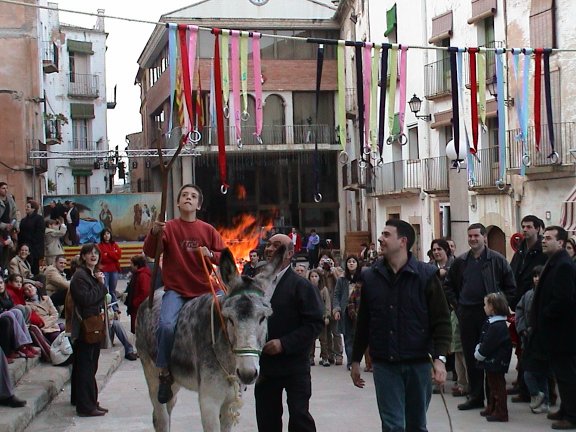
|
| |
The
scarf
Name used in other
European regions:
Name of the person
who explained the game: Anna Mur Suñé, from Flix (12)
Number of players:
In teams. A maximum of 20
Ideal place to
play it: A square or a pedestrian street
Material: A
scarf
Explanation:
Two teams with the same number of players are separated by 20m.
Each person has a
number but the opponent group doesn't know the number.
One person stays in
the middle of both teams holding a scarf in his hand. Then he says one
number aloud.
The player of each
team with that number starts running to fetch the scarf. The objective
is to fetch the scarf and go back to his place without being touched by
the opponent. If he is touched, he is eliminated, if not, the opponent
is the one who is eliminated.
Those who are eliminated
stay next to the person who leads the game and can be saved by a partner
if, when catching the scarf, they are touched and go back to their group
without being touched by the opponent.
The game finishes
when one of the teams is left without any player.
It's a typical summer
game, played in the street, or when you go to the countryside, to the
hermitage…
Explanation of
the same game in other European regions:
Photograph/picture
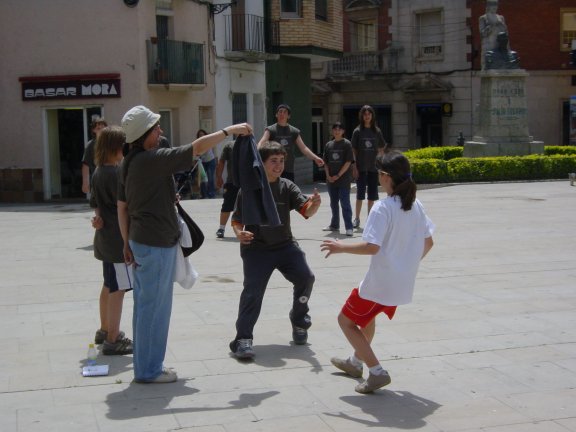
|
| |
The
greasy pole
Name used in other
European regions:
Name of the person
who explained the game: Pau Guiu Rofes, from Flix (13)
Number of players:
Individually
Ideal place to
play it: Go across on the boat, in the Ebre river
Material: The
organization hangs some strips on the extreme of a pole, situated horizontally,
and they grease it.
Explanation:
First you have to hold a pole horizontally over a boat. Then you grease
it so that it's slippery. When you have finished you tie a scarf to the
end of the pole.
Everybody can participate.
The objective of this
game is to get the scarf which is hung at the end of the pole.
Participants, one
by one, try to go across the pole, which is slippery. This is very hard
and if you fall, you fall into the river.
The one who gets the
furthest scarf is the winner. The one who gets the scarf in the middle
comes second. The one who gets the scarf which is the lowest comes third.
This game is also
played during the main fiestas in Flix, where there are always people
aged from 18-26 years old prepared to play the game, although there are
also people under age.
In the main fiestas
of Riba-Roja they also play it.
Explanation of
the same game in other European regions:
Photograph/picture
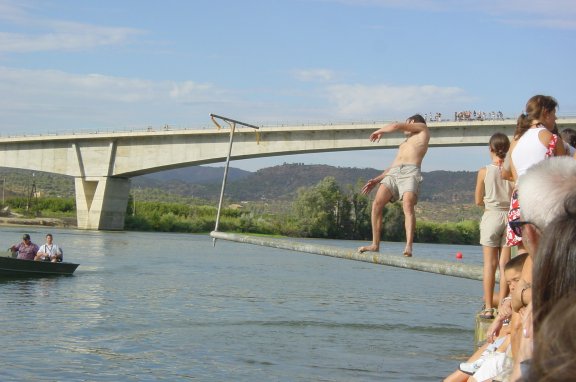
|
| |
Basket
or stones race
Name used in other
European regions: Cobs race (in the rest of Spain )
Name of the person
who explained the game: Carla Fernández Montaña, from
Ascó (13 ) and Judith Sans Serra, from Ascó (12 )
Number of players:
It depends on the number of baskets. Usually 5 per race.
Ideal place to
practise it: A flat ground of 15 m. approximately.
Material: At
least 5 baskets and 10 river stones per basket
Explanation:
The game consists of collecting 10 stones, as fast as possible, in a row
in front of the basket. The stones are separated 1m from each other.
When the game starts,
each player has to run and put his stones, one by one, in his basket.
Each time, however,
you can only take 1 stone and put it in the basket, and then start running
again to take another one.
You can't touch the
basket which is outside the starting line.
The order to start
collecting stones doesn't matter. You can start with the first stone,
the last one or the middle one.
The winner is the
one who gets all the row of stones in front of him.
It's a traditional
game that Asco has recovered and it's played on St. Anton Day, on 17th
January.
Explanation of
the same game in other European regions:
Photograph/picture
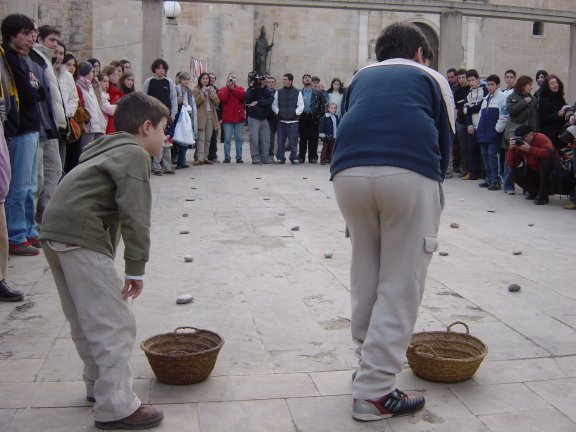
|
| |
Hopscotch
Name used in other
European regions:
Name of the person
who explained the game:Anna Mur Suñé, from Flix (12)
and Ricard Ribes Serra, from Ascó (12 )
Number of players:
5 maximum
Ideal place to
play it: A flat square
Material: A
piece of chalk and a flat stone.
Explanation:
Draw a hopscotch on the ground. In turns, each player throws a flat stone
to the corresponding square. You start by the first one and you go up.
The stone has to fall inside the square without touching the sidelines.
Then you have to follow the hopscotch as follows: You have to go through
all the squares successively, skipping the square with the stone in it,
hopping, without crossing the lines and without using the other foot.
If during the way
you find a square with a cross and none of the squares has a stone in
it, you can't put one foot on each square. When you arrive at the last
square, you turn and go back to the start. When you are at the square
previous to the one that has the stone, you have to bend down, take it
and go back to the start with it. If during this route the player touches
the ground with both feet, crosses the line, or doesn't throw the stone
well, another player will take his turn. If you do all the route, you
continue with the following square until you have done all of them. The
winner is the one who finishes the route first.
Explanation of
the same game in other European regions:
Photograph/picture
|
| |
|
| |
|
| |
|
| |
|
| |
|
| |
|
| |
|
| |
|
| |
|
| |
|
| |
|
| |
|
| |
|
| |
|
| |
|
| |
|
| |
|
| |
|
| |
|
